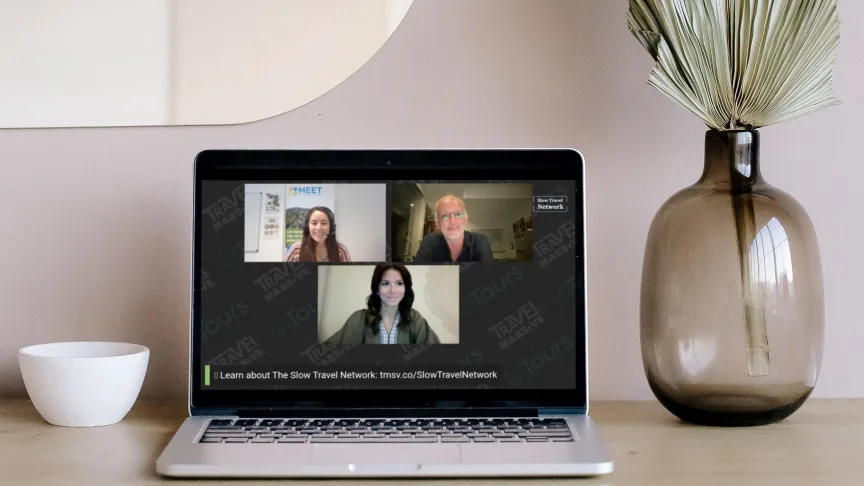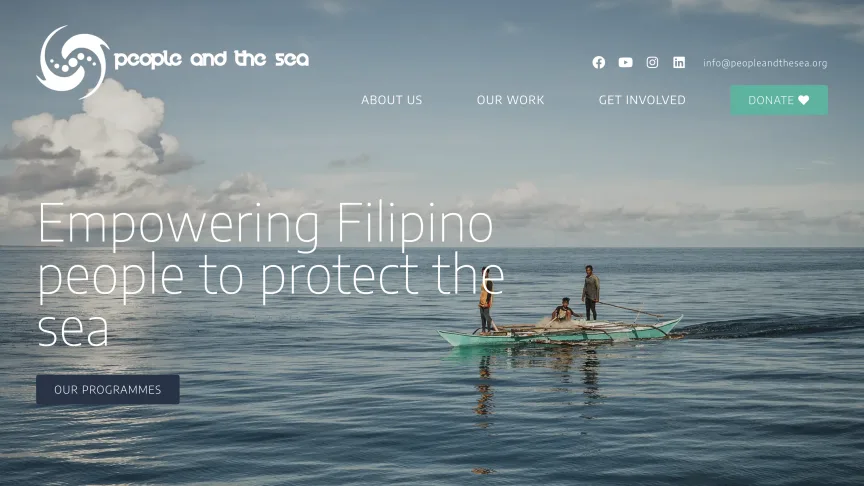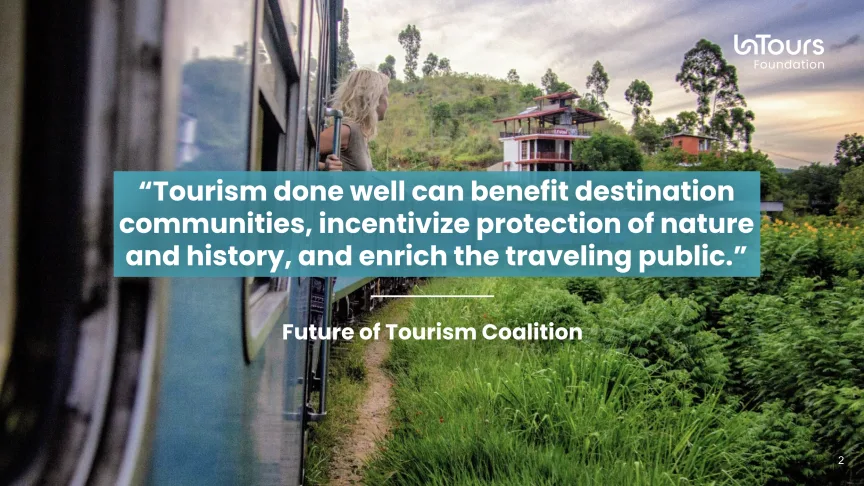We talk with Sarah Payne, Director of Impact at UnTours Foundation, and Stuart McDonald, co-founder of Travelfish about examples of slow travel initiatives, how to measure impact from tourism projects, the travel scene in SouthEast Asia, advice for entrepreneurs, and the Reset Tourism Fund.
This article features highlights from our live interview with Sarah and Stuart on the Slow Travel Network — skip to the end of this article if you’d like to watch the full interview.
 Sarah and Stuart were guests on our Slow Travel Network webinar, moderated by Lucía Prieto from MEET Network.
Sarah and Stuart were guests on our Slow Travel Network webinar, moderated by Lucía Prieto from MEET Network.
Sarah: I’m Director of Impact at the UnTours Foundation which owns UnTours - the world’s first certified B Corporation.
The UnTours Foundation invests 100% of our endowment into businesses at the forefront of tackling the climate crisis, social injustice, as well as trying to create positive social and environmental impact in the world.
We recently launched the Reset Tourism Fund which is a $10 million fund that’s focused specifically on investing in world-changing businesses in the travel and tourism industry.
Stuart: I’m Australian but I’ve been running around in Southeast Asia since 1993. In 2004 my wife and I started Travelfish – an online guidebook to Southeast Asia. We’re both reformed backpackers.
Pre-pandemic we had a team of writers that was helping us put the material together. When the pandemic hit, obviously business slowed down. So I started Couchfish – a newsletter that we designed to bring travel to people who were stuck on their couch and it traces a fantasy itinerary through Southeast Asia.
As time went on I also got much more involved in commenting on sustainable tourism and where tourism is going in Southeast Asia. I’m also writing about how things could be done in different ways that would be better for local people and for the environment in general.
Example 1. UnTours (United States)
 UnTours is the the world’s first B Corp certified business and offers trips to Europe lasting 7+ days
UnTours is the the world’s first B Corp certified business and offers trips to Europe lasting 7+ days
Sarah: The first one I want to highlight is actually UnTours – the company that we operate. The company was started back in the 1970s by a really cool entrepreneur named Hal Taussig who was really passionate about this very topic, about slow travel, about how we interact with communities in a way that is responsible and culturally enhancing.
We offer trips to Europe where you’re staying in one place which allows you to get to know the local people in the community better. With UnTours we’re really focused on those longer trips, fewer destinations, lesser footprints, and really immersing yourself in the destination.
Example 2. Kapawi Ecolodge (Ecuador)
 Juan Carlos Garcia from Kapawi Ecolodge presenting at the Adventure Travel World Summit in Hokkaido, Japan
Juan Carlos Garcia from Kapawi Ecolodge presenting at the Adventure Travel World Summit in Hokkaido, Japan
Sarah: Kapawi Ecolodge in Ecuador is the winner of the recent Adventure Innovation Challenge, a pitch competition at the Adventure Travel World Summit in Hokkaido. The pitch competition featured three cutting-edge tourism entrepreneurs who competed for cash prizes totaling $7,500 and the opportunity for investment from the UnTours Foundation’s Reset Tourism Fund of up to $50,000.
Kapawi Ecolodge is 100% indigenous-owned, and 100% solar-powered. They welcome travelers to experience their local cultures, but in a way that is very authentic and it’s all community-directed. When they bring in travelers they make it very intentional so guests can slow down and pause. They don’t have Wi-Fi at the facility, and you have to take a small plane to get there, which automatically screens the kind of travelers that are coming to Kapawi.
Example 3. Dapur Tara Flores (Indonesia)
 Meet Ratna and Kris at Dapur Tara Flores. Photo: Stuart McDonald
Meet Ratna and Kris at Dapur Tara Flores. Photo: Stuart McDonald
Stuart: Dapur Tara is a homestay in Flores island, Indonesia. The island is most famous for Komodo National Park and for diving. The homestay is located about a 20-30 minute motorbike ride from the coast. It was established by a woman from Flores called Liz. She wanted to show the true flavors of Flores, away from the commercial tourism developments.
They’re working with a local school to identify kids who Liz calls Golden Kids. They want to give them more options than just making a bed in some great big hotel where they’re going to have zero job security.
The homestay is very simple and it’s solar powered, and there’s no Wi-Fi — it’s not fancy or anything like that. It was a real lesson to me that you don’t have to have huge financial support to do something that’s really making a difference.
Example 4. People and the Sea (Philippines)
 People and the Sea – Cebu, Philippines
People and the Sea – Cebu, Philippines
Stuart: People and the Sea is an organization on Malapascua Island off the northern tip of Cebu, Philippines. It’s a collaborative effort between people from the island called Malapascua off the top end of Cebu and some French people. Because the island is tiny, they work on everything including waste management, community development, and coral reef preservation.
Sarah: This is something that a variety of organizations are trying to understand – how do you measure the impact of any community-based project regardless of sector?
The impact should be defined by the people that are impacted. Good intentions are not enough. The conversation has to be participatory of local communities from the very beginning. It’s really about going into the local communities and quite simply asking “did the quality of your life improve?” – it’s a very simple metric. If you’re trying to see if the project has a positive impact on livelihoods, who better to ask than the people who are impacted.
There are also some helpful frames for this such as the UN Sustainable Development Goals – they’re often too large to use as specific measurements but great as general themes to pay attention to. The GSTC frameworks are really helpful for understanding impact but again there are so many dimensions to consider – there’s the environmental impact, preserving biodiversity, ecosystems, and wildlife, then there’s social impacts as well, and in terms of inclusion and women’s empowerment.
But we don’t want to spend too much time with vanity metrics. We need to define going in what are the goals, what are the outcomes that we want to see and what are the outputs that we can measure to start to understand if we’re generating those outcomes and ultimately the right impact.
Lucia (moderator): Locals are at the very base of everything so you have to take into account the local community from the very beginning and not get there one year later and say “we are doing this I hope you’re okay with it”. They have to be part of the initiative because if they’re not considering it their own in a way, there’s no longevity.
Stuart: The travel scene in Southeast Asia has definitely changed with time. I’ve been traveling around here since the early 90s and it is far easier to get around than it used to be. Travel patterns have changed. Gap year travelers, which used to be an important sector of the inbound market, are not in the same volume anymore. Low-cost airline carriers like Air Asia have just completely changed how people travel. It’s now possible to go to Angkor Wat for a weekend from Singapore and previously you’d have to pay a lot more to have done that – now you can do it for 100 dollars.
People are seeing more in less time which is the antithesis of slow travel. With the opening of Vietnam and Cambodia and the accessibility of air travel, people are now seeing four countries instead of one for the same amount of time. So there’s not that many people slow traveling like before.
There’s no magic number of how long you “have to” spend in a destination for the trip to be considered slow but it’s all about the intention you put in your trip and the choices you make on how to spend your money.
I wrote a piece about slow travel in Huế, a city in Vietnam, for example. Of course, there are all these museums and places to see but I said go there and restrict yourself to only one neighborhood for a whole day. It sounds ridiculous but it’s easily a day-worth of experiences in any city block.
Years ago I was in New York City and I walked from Central Park to what was in the World Trade Center - it took me all day and maybe I passed by one hundred blocks but it felt like walking through 58 different countries within New York. I could’ve easily spent a day in each of these blocks. So it all comes to your mindset.
Sarah: I think one of the main challenges is something that we talked about earlier: How do you make sure that you’re engaging the local stakeholders and giving local people that primary voice in whatever you’re doing?
If you’re creating that kind of tourism initiative, make sure you’re doing it right from the beginning, otherwise these good intentions can actually sometimes lead to negative impacts.
A definite challenge is how do you balance accessibility versus a positive social and environmental impact – how to make sure that your tour, for example, is accessible to more people but yet the business model works in such a way that money is flowing directly to the local people.
It’s important to outline from the very beginning what the impact is you want to create and how you create it without degrading the local culture, and preserving it instead.
There are a lot of other typical entrepreneurial challenges, typical tourism industry challenges, such as not having access to resources, and the seasonality of the product. So that’s where players like us at UnTours Foundation can come into play with some revenue-based solutions to help scale a tourism initiative.
 The Reset Tourism Fund is investing capital into the world-changing businesses shaping the future of tourism.
The Reset Tourism Fund is investing capital into the world-changing businesses shaping the future of tourism.
Sarah: We created the Reset Tourism Fund because there are a lot of people talking about the potential of tourism to create a better world but there’s not necessarily enough capital flowing into the travel businesses.
80% of the businesses in the tourism industry are small businesses. They’re on the front lines of travel and tourism. Often, when we think about investing, we think about who’s scalable and where are the unicorns. That’s not our approach here. We really want to fund the organizations that can create that long-term local impact.
We’re providing check sizes from just 10 to 100,000 USD so they’re fairly small Investments but that’s because of who we’re targeting. We’re trying to find these companies that are doing the real work and need a little bit of extra resources.
The Reset Tourism Fund is all about recognizing that there is huge potential for travel and tourism to create positive impacts. We are finding those world-changing entrepreneurs who are not only minimizing their negative impact but proactively trying to be part of regenerating the local environment.
We’re not trying to be a typical investor either. We are trying to make our capital accessible at the lowest cost. We offer revenue-based financing so that you’re only paying back an investment based on the percentage of your revenue, so that in a low season, if you make no revenue, you don’t owe us anything.
We’ve invested in Peru, Kenya, Australia and many more. Right now we do have a real focus on investing in companies that are making travel and tourism accessible, especially for BIPOC, youth, women, and LGTBQ+ travelers.
We’ve invested in companies like Greenbook Global which is all about the black travel experiences. We’ve invested in a company in Australia that provides experiences for neurodivergent youth, and many more.
Investment is not the right solution for everyone. There are a lot of other resources available. For example, our funding partners, TUI Care Foundation, and Expedia Group have really great grant and donation programs if you’re a small community-based tourism enterprise.
👉 Learn more at untoursfoundation.org/reset-tourism-fund
Sarah: It’s all about how are we centering the people that are impacted in this conversation. It comes back to have you checked what the local community actually wants and have they actually been given a chance for all voices to be heard.
For example, Kapawi Ecolodge in Ecuador is organizing a day-long summit where they’re going to gather hundreds of people from across the local communities. They’re going to talk about where they want to go next in terms of tourism and bringing new travelers.
Community Development is not easy so it’s all about what is decided by the community itself - whether it’s bringing more people, or Westernized coffee shops, opening more jobs, or keeping it simple and less touristy.
Stuart: I just want to add that there’s always going to be people in the community that have different visions. There will be some people who want a Starbucks, there are going to be people who want to weave baskets. So it is going to be complicated but it’s important to start this conversation and get the consensus all together.
Stuart: Travelers need to do some research. It’s not so easy to find those non-commercial places. If travelers put as much effort into research beforehand as they do in finding cheap flights, it would be a different picture. It’s about changing your focus – slow travel is a state of mind. It doesn’t matter if you’re spending somewhere a day or a decade, it all starts with your mindset. It can be as simple as walking around instead of taking public transportation – you can find so many small businesses that way. It’s a step-by-step approach, you don’t have to go out of your comfort zone straight away.
Sarah: It’s that balance of doing your research beforehand, not over-scheduling and actually planning some time where you can just be and feel things out once you’re at the destination. Some of the best things are not going to be widely advertised, you simply show up and ask people.
If you enjoyed this article and want to hear more, see our full interview with Sarah and Stuart below.
Powered by UnTours, the Slow Travel Network unites 500+ content creators, tour leaders, and travel insiders on a mission to develop stories and highlight outstanding and replicable ways travelers and the tourism industry are making the world better through #slowtravel.
– Thanks to Sarah, Stuart, and Lucia (moderator) for sharing their stories and insights!

Comments